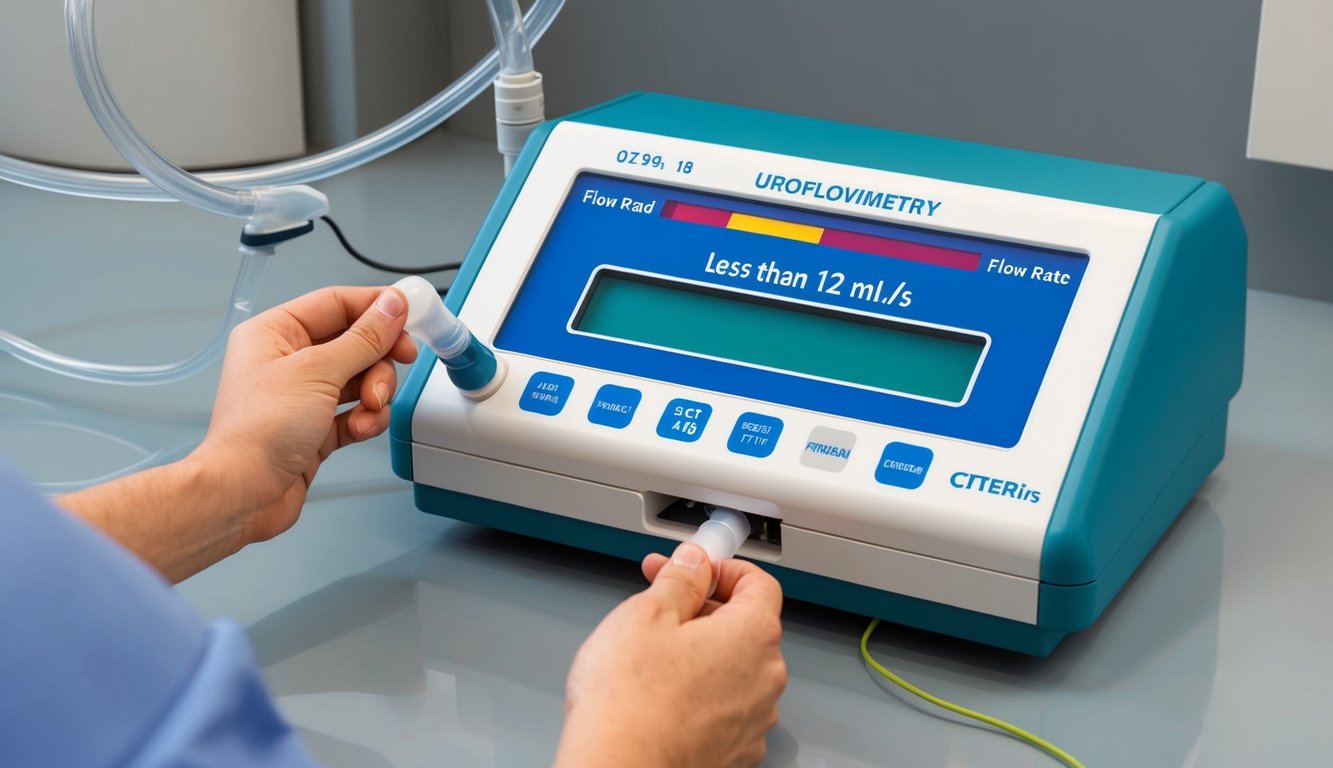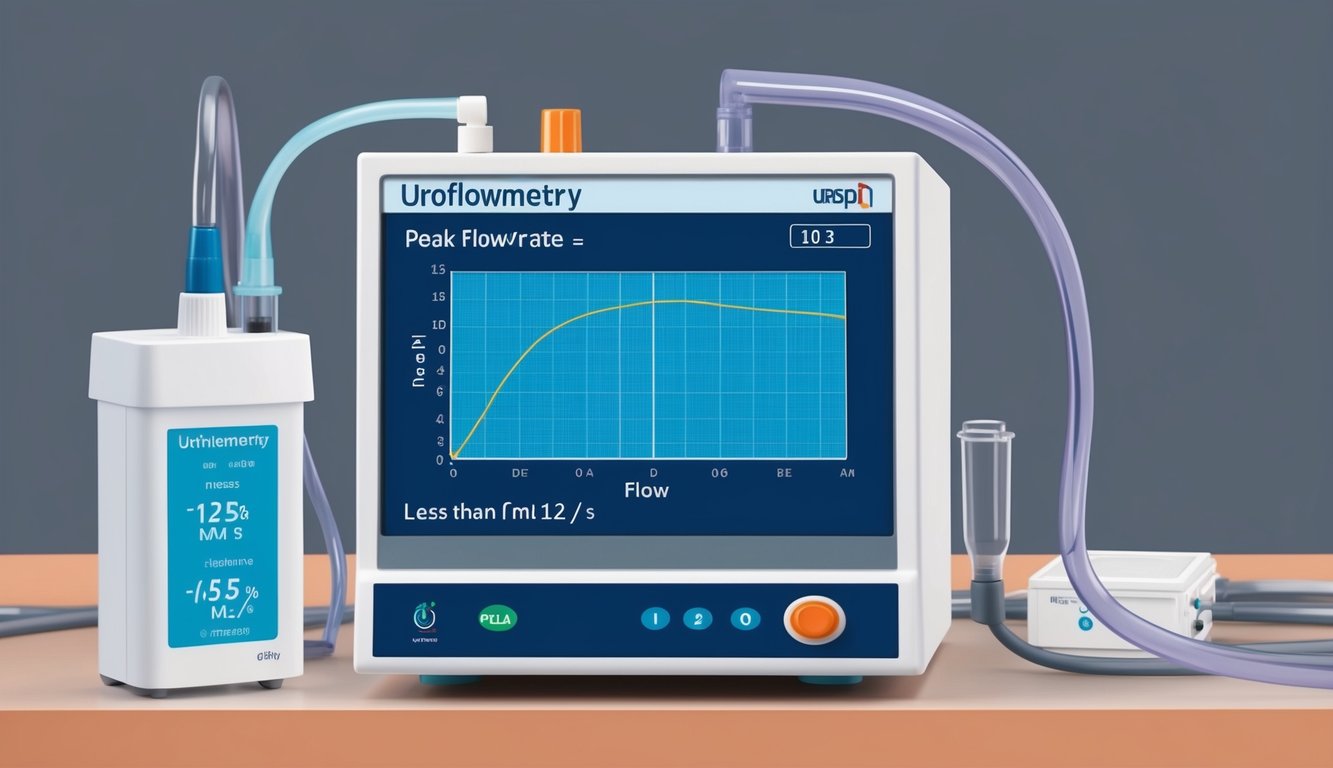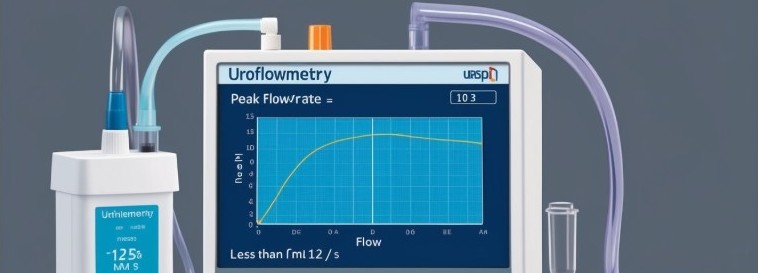Uroflowmetry: Maximum flow rate (Qmax) less than 12 mL/s – Understanding Low Urinary Flow and Its Implications. Ok, so here we go, you can no longer write your name in the snow. Heck you are lucky if you can keep the piss off your pants.
I get it, this is known as low flow rates, and you should look into it sooner rather than later. Low flow rates may lead to complications such as urinary tract infections, bladder stones, or kidney damage if not properly investigated and managed.
Dr. Lin from Sunrise Urology does a good job of explaining this in the following YouTube video.
Uroflowmetry is a non-invasive diagnostic test used to evaluate urinary flow. It measures various aspects of urination, including the maximum flow rate, known as Qmax. A Qmax value less than 12 mL/s can indicate potential issues with the urinary system.

A maximum flow rate (Qmax) below 12 mL/s often suggests an obstruction in the urinary tract or weakened bladder function. This result may be associated with conditions such as benign prostatic hyperplasia in men or pelvic organ prolapse in women. However, it’s important to note that Qmax values should be interpreted alongside other clinical findings and patient symptoms.
Understanding your uroflowmetry results can help guide treatment decisions and improve management of lower urinary tract symptoms. While a low Qmax value may be concerning, it’s just one piece of the puzzle in assessing urinary health. Your healthcare provider will consider this result in conjunction with other factors to determine the most appropriate course of action.
Key Takeaways
- Uroflowmetry measures urinary flow, with Qmax being a key indicator of urinary health
- A Qmax below 12 mL/s may suggest urinary tract obstruction or reduced bladder function
- Interpreting uroflowmetry results requires consideration of multiple factors beyond just Qmax
- Leaving low flow rates uninvestigated can lead to complications.
Understanding Uroflowmetry
Uroflowmetry is a non-invasive urodynamic test that measures urine flow rate. It provides valuable information about lower urinary tract function and helps diagnose various urological conditions.
The Basics of Uroflow Tests
Uroflowmetry measures the speed and volume of urine flow during urination. Patients urinate into a special funnel-shaped device called a uroflowmeter. This device records data such as maximum flow rate (Qmax), average flow rate, voided volume, and time to maximum flow.
The test is simple and painless. Patients are asked to arrive with a comfortably full bladder. They urinate normally into the uroflowmeter in a private setting. The entire process typically takes only a few minutes.
Uroflowmetry is often combined with other urodynamic tests for a more comprehensive evaluation of urinary function.
Interpreting the Flow Curve
The uroflowmeter generates a flow curve that visually represents the urine flow over time. A normal flow curve resembles a bell shape, with a gradual increase in flow rate, a peak, and then a gradual decrease.
Key parameters on the flow curve include:
- Qmax: Maximum flow rate
- Time to Qmax
- Voided volume
- Flow time
Abnormal patterns may indicate various urological issues. For example, a flattened curve with a low Qmax could suggest urinary tract obstruction or weak bladder muscles.
Healthcare providers analyze these patterns alongside other clinical information to make accurate diagnoses.
Factors Affecting Qmax
Qmax is a crucial parameter in uroflowmetry interpretation. Normal values vary by age and gender. For adult males, a Qmax of 15 mL/s or higher is typically considered normal.
Several factors can influence Qmax:
- Age: Flow rates tend to decrease with age
- Gender: Women generally have higher flow rates than men
- Voided volume: Larger volumes usually result in higher flow rates
- Urinary tract conditions: Obstructions or weak bladder muscles can reduce flow rates
It’s important to note that a single low Qmax result doesn’t necessarily indicate a problem. Repeated measurements and consideration of other clinical factors are essential for accurate diagnosis.
Clinical Implications
A maximum flow rate (Qmax) below 12 mL/s often indicates potential urological issues. This measurement provides valuable insights for diagnosis and treatment planning in various lower urinary tract conditions.
When Qmax Is Less Than 12 mL/s
A Qmax below 12 mL/s typically suggests bladder outlet obstruction or detrusor underactivity. This reduced flow rate can impact bladder emptying efficiency and may lead to complications if left untreated.
Patients with low Qmax often experience:
- Difficulty initiating urination
- Weak urine stream
- Prolonged voiding time
- Incomplete bladder emptying
These symptoms can significantly affect quality of life and may indicate underlying urological conditions requiring medical attention.
Potential Urological Conditions
Several conditions can cause a Qmax below 12 mL/s:
- Benign prostatic hyperplasia (BPH): Enlarged prostate gland obstructing urine flow
- Urethral stricture: Narrowing of the urethra
- Detrusor underactivity: Weak bladder muscle contractions
- Neurogenic bladder: Nerve-related bladder dysfunction
These conditions may lead to complications such as urinary tract infections, bladder stones, or kidney damage if not properly managed.
Treatment and Management Strategies
Treatment for low Qmax depends on the underlying cause:
- For BPH: Alpha-blockers, 5-alpha reductase inhibitors, or surgical interventions like transurethral resection of the prostate (TURP)
- Urethral strictures: Dilation procedures or urethroplasty
- Detrusor underactivity: Pelvic floor exercises, biofeedback therapy, or intermittent catheterization
Regular urodynamic studies and post-void residual measurements help monitor treatment effectiveness. Lifestyle modifications, such as timed voiding and reducing fluid intake before bedtime, can also improve symptoms.
In some cases, combination therapies may be necessary to address multiple factors contributing to low Qmax. Ongoing follow-up with a urologist is crucial for optimal management and prevention of complications.
Frequently Asked Questions

Uroflowmetry results, particularly the maximum flow rate (Qmax), provide valuable insights into urinary health. A Qmax below 12 mL/s can indicate various urological issues that require further investigation.
What factors could lead to a Qmax of less than 12 mL/s in uroflowmetry?
Several factors can contribute to a low Qmax. Enlarged prostate, urethral strictures, and weak bladder muscles are common causes. Neurological conditions affecting bladder function may also result in decreased flow rates.
Certain medications, particularly those affecting smooth muscle function, can impact urine flow. Dehydration and inadequate bladder fullness during the test may lead to artificially low Qmax values.
How does age affect normal urine flow rate in uroflowmetry tests?
Age plays a significant role in urine flow rates. As individuals age, their Qmax tends to decrease. Flow rates typically decline by 1-2 mL/s every 5 years, with a maximum flow rate of about 5.5 mL/s expected at age 80.
This gradual reduction is often due to natural changes in the urinary system, including decreased bladder muscle strength and prostate enlargement in men.
What are considered normal and abnormal Qmax ranges in uroflowmetry?
Normal Qmax ranges vary by gender and age. For adult males, a Qmax of 15 mL/s or higher is generally considered normal. Females typically have slightly higher normal ranges.
A Qmax below 12 mL/s is often considered abnormal and may warrant further investigation. Values between 12-15 mL/s fall into a gray area and are evaluated alongside other clinical factors.
What can an abnormal uroflowmetry test suggest about a patient’s urinary system health?
An abnormal uroflowmetry test, particularly a low Qmax, can suggest various urological issues. It may indicate bladder outlet obstruction, such as benign prostatic hyperplasia in men or urethral strictures.
Weak detrusor muscle function, neurogenic bladder disorders, or urinary retention might also be underlying causes. The test results guide healthcare providers in determining appropriate next steps for diagnosis and treatment.
How are uroflowmetry results like Qmax used in the diagnosis of urinary disorders?
Qmax and other uroflowmetry parameters serve as important diagnostic tools. They help identify potential urinary tract obstructions or functional issues of the bladder and urethra.
These results, combined with other clinical data, assist in diagnosing conditions such as benign prostatic hyperplasia, urethral strictures, and detrusor underactivity. They also aid in monitoring treatment effectiveness and disease progression over time.
What repercussions does a low Qmax have on the evaluation of lower urinary tract symptoms?
A low Qmax prompts a more comprehensive evaluation of lower urinary tract symptoms. It often leads to additional diagnostic tests such as post-void residual volume measurement, cystoscopy, or urodynamic studies.
The finding may influence treatment decisions, including medication choices or the need for surgical interventions. It also helps in assessing the severity of conditions like benign prostatic hyperplasia and guiding appropriate management strategies.

